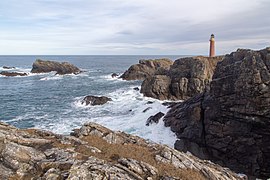Butt of Lewis | |
|---|---|
Headland | |
 Butt of Lewis | |
| Coordinates: 58°30′56″N6°15′40″W / 58.5156°N 6.26119°W | |
| Grid position | NB 51951 66481 |
| Native name | Rubha Robhanais (Scottish Gaelic) |
The Butt of Lewis (Scottish Gaelic : Rubha Robhanais [a] ) is the most northerly point on the Island of Lewis, in the Outer Hebrides, Scotland. The headland, which lies in the North Atlantic, is frequently battered by heavy swells and storms and is marked by the Butt of Lewis Lighthouse. The nearest populated area is the village of Eoropie, about 1 mile (1.5 kilometres) to the south. [1] [2]
Contents
The road to the lighthouse passes a sheltered cove called Port Stoth. Southwest from the lighthouse is a natural arch called the "Eye of the Butt" (Scottish Gaelic : Sùil an Rubha).
It is claimed that the Butt of Lewis is one of the windiest locations in the United Kingdom. [3] [4]




